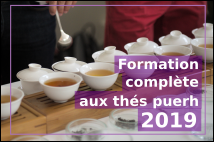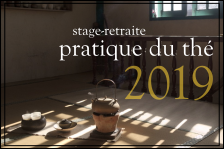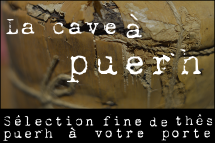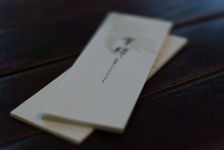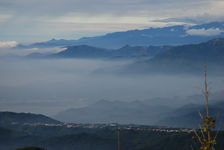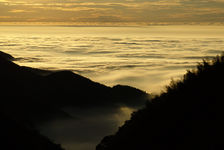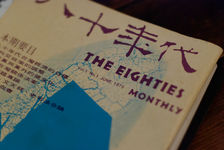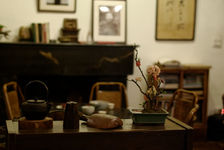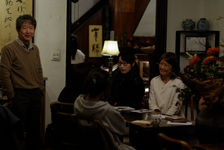 This page is not a real translation but just an automatic translation generated by computer of the original article, written in French language! Its not good... but better than nothing!
This page is not a real translation but just an automatic translation generated by computer of the original article, written in French language! Its not good... but better than nothing!Want to help us do diffuse puerh tea culture in english, by providing a better (or corrected) translation?
Please contact us!

Chow Yu is one of the must face the world of tea and has played an important role in the revival of the tea culture in Taiwan in the 80s. The legacy of a historic site founded by his father, Professor David Chow, who was an important place of critical and political debate in Taiwan since the 50s, Chow Yu founded in 1981 Wistaria Tea House, now a historical site Taipei. With this tea house Chow Yu is a new approach to tea in the Taiwanese landscape 80s.
Inspired by European salons of the 18th century, Wistaria Tea House is an essential role of culture in Taiwan, and for more than two decades stood side by side within its walls, activists, artists, thinkers and lovers tea. But more than a place Wistaria is a reflection of the spirit of Chow Yu, philosophy balance between Western modernism and Taoism, and its relation to tea.
Pending a full coming of Chow Yu and his vision of tea article, I am pleased to present to you today, in French, an article written by Chow Yu in person, there's almost two decades ago, in 1995, and beautifully introduced the magic of tea.
A big thank you to Chow Yu to give us a few lines.
All nature in a cup of tea -by Chow Yu
To the Western mind, pretend as does the poet "see the world in a grain of sand" is more a kind utopia. Yet this sentence is immediately understood by any amateur Asian Wu-long tea or green tea known in the aroma of some tea leaves, find the essence of nature, the mountains and rivers, grass and rocks. subtle emanations For a cup of tea Lung-chin, collected on the shores of West Lake in Hangchow, arise in the imagination of Chinese drinker scenic surroundings on the banks of the water areas to the south of the Yangtse. A cup of tea harvested in Wulong mountain in Taiwan evokes against the sky azure and white clouds that crown the Formosan mountains and its delicate fragrance transports who takes delight to high areas where a clear breeze. Sensations exquisite than the tea that invaded the palace and caress the tongue! A scholar of yesteryear are reconaissait "fresh burst of a source in the language."
This is the tea as a red wine its flavor and aroma are alive and changing. There are some two thousand six hundred years the sage Lao Tzu found that "the matter is chagement." By this he meant to express the essence of life, the Tao, is manifested in the phenomenal world constantly under different aspects. The oldest book of Chinese philosophy for Title I or King Yi-Ching, which can result in Book of Yi 易. This character means both change and ease appears wonderfully appropriate to evoke the subtle variations in the aroma of the tea and the images it produces. The tea is good and beautiful effect an easy way to access multiple natural world. But how this miracle occurs? Probably the mysteries of Heaven do they have them, but just as the causal reign on earth.
The mystery of the tea leaf
The tea leaf has an extraordinary virtue:its ability to impregnation. It is indeed easily permeates the smell, the smell of anything with which it comes into contact. This principle has long been the remains found its application in the jasmine tea when tea leaves and flowers are mixed so that the fragrance of flowers is absorbed and retained by the leaves. And unfold in a cup of tea we drink in the fall or winter all the flavors of spring and summer. It also happens sometimes that the tea leaves of inferior quality are used against bad odors placed in a pantry, they absorb the oily smell of donuts is just fried.
It is therefore not surprising that tea trees growing on the mountainsides by their leaves absorb the flavors that bathe and even a little of the volatile spirit of the mountains and streams. Perhaps this is where we get the wonderful power of seduction of tea.
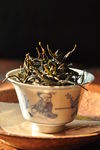
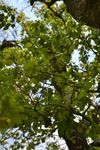
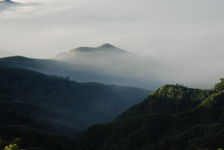
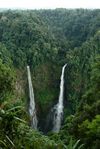
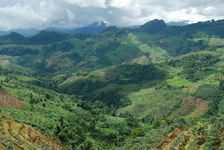
- 1.Tea leaves in a gaiwan Copyright Sébastien Vacuithé
- 2.Millennium Tree Leaves in Yunnan
- 3.Mist in the mountains of Taiwan
- 4.Waterfall in Laos
- 5.Mountain landscape in Yunnan
If the tea leaves naturally enclose the mysterious beauty of nature, it was not easy to find the key to get them out. Few millennia of trial and error was needed for Chinese, for almost a thousand years, are kept unfermented tea or green tea. Although the Tang Dynasty (618-907) and Sung (960-1127) have been developed refined tea processing techniques and some prestigious teas were produced, it was still far from having explored all the potentialities of the small green leaf. It was not until seven or eight hundred years that were discovered the secrets of fermentation of the tea leaf and techniques for the trigger and the stop could be controlled. Only the fermentation medium or low as the case of Wu-long freeing all the energy of the soul of the hidden in the leaves nature.
Even though she left early the tree that nurtured the tea leaf, after fermentation, clear and ample rich perfumes shimmering range including the delicate freshness of the young orchid elegance flourished both osmanthus blossom. A longer fermentation even produce ripe fruit flavors. By fermentation born much more subtle flavors and aromas, direct expressions of life, by the process which was to smoke tea leaves with flowers slowly consuming. For Westerners used to the only black tea with high fermentation, There are there to discover a universe. There's them, however, in the seventeenth and eighteenth centuries Europeans to make their country a "wonder" tea they did enjoy in the princely courts of the nobility and intellectuals. It was Wu-yi tea harvested in the mountains of northern Fukien (Fujian). This tea called "bou-hi" in the language of Fukien, was introduced as the Europoe Bohea (English pronunciation).
Origin and development of the civilization of tea in the Chinese world
In Taiwan, tea is consumed for a little more than four hundred years, when Han settlers (ie Chinese) introduced it from Fukien and Chaoshan region (north-east the province of Canton). When the operation of planting and preparing tea for commercial purposes, it only really developed only during the last two hundred years. Drinking tea is a custom that originated it there's maybe four thousand years in the southwest of the province of Szechuan (Sichuan). Originally, tea was used as a medicinal plant. When in 221 AC The Emperor Chin Shih Huang had unified China, tea made its appearance in the middle and lower reaches of the Yangtse. To the seventh century AD, when the habit of drinking tea had already conquered Northern China, a man of the people, some few singular scholar named Lu Yu, Collectable all information about the methods used for nearly a thousand years in China to plant, process, prepare and enjoy tea. He then meets a book, Cha-King or Book of Tea, which is the first book ever written about the subject. Despite its age, this book still valuable lessons, remained a reference.
Thereafter, tea spread at an increasing rate throughout the Far East, in both regions Han population than among neighboring populations for whom it became necessary, both for its therapeutic virtues as sensual pleasure, both as fine art for religious libations. Over the centuries that followed, the success of the tea throughout the Far East was confirmed in various forms and various and successive modes, but still quite elaborate. Having mastered the cultivation and processing of tea leaves, tea culture is enriched by the art of making tea and no less than to appreciate not only the infusion, but the water used. Nowadays, there are countless books on tea written over the centuries, just as poems, paintings, wood carvings on the tea utensils for tea found in ancient tombs, that they were earthenware, porcelain, bamboo, lacquer, gold, silver, bronze, iron, tin and other materials.
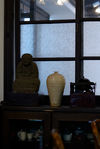
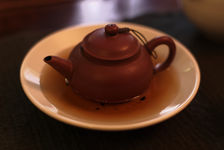
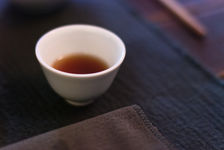
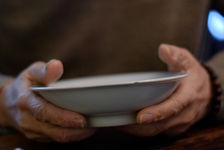
- 1. Wistaria Tea House
- 2.Teapot Yixing clay Wistaria Tea House
- 3.Teacup Wistaria Tea House
- 4.Tea Bowl in the hands of Chow Yu
Many bowls, cups, jars tea recently found in graves and manufactured the famous kilns which are developed from Tang reflect the consummate artistry which had reached the ceramists to Tang and Sung periods. Their shapes and colors are so perfect and so smooth that sometimes hard to believe they may have been produced by humans. The beholder, is invariably confused by so much beauty. From four to five hundred years, Wulong tea brewed mostly in teapots made purple earth Yi-hsing (Xing Yi). The variety of shapes and creativity that it reflects the pottery from the fifteenth century to new heights, and for the first time then, ceramists artisans proudly etched their name in their creations. It also notes that the development of the art of tea has not been without influence strongly and music arrangement of gardens and architecture, clothing and many other arts again. By uniting closely Confucian thought, Taoist and Buddhist art of tea is also involved in ethics, rituals, culture of the mind, religion and a certain vision of the world.
Two different approaches:tea in the Chinese world and its Japanese-doo
The Chinese are commonly regarded by the West as Confucianism. But in China, the influence of Confucianism is in fact limited to the moral, logical, social system and statecraft. In terms of art, literature, science, medicine, agriculture, crafts or design of nature and the world, the Chinese are the son Tao.
In their eyes, the Tao is real, it is the source of all life, of all that exists, and all forms. Underlying principle in every phenomenon, however, is elusive. Present in everything, it is indefinable as expressed phrase Lao Tzu:"The Tao that can be spoken is not the Tao." This naturally implies that one can not in any field or set standards define forms in which would fit the Tao. Therein lies a truly ethno-cultural difference between China and the perception of the Japanese people.
These are Japanese monks, staying in the thirteenth century temples chan (zen) in southern China, it discovered a tea ritual art through the centuries and they instroduisirent in their country at the same time they reported tea leaves, cuttings and utensils for preparation and tasting. After three centuries of slow evolution, the tea ceremony atteingnit its clearest form in the strict formalism defined by the Grand Master of Japanese Tea Senno Rikyu. However, it would be wrong to believe that the Japanese sadoo to be developed without any influence. Even before the tea arrived in the land of the Rising Sun, Confucian thought and ritual she loved, like Buddhism, had a profound impact on Japanese culture, would that through writing borrowed Chinese world.
It is nowadays still difficult to understand why the rules and formalism are so important, see fundamental for the Japanese. One explanation may be that in their view, only the discipline rules as intangible contraigrante can provide access to the Tao. It is quite different to the Chinese, who certainly do not think to the extent that the arts can flourish outside of any rules, but who believe that they are born primarily of the dialectical experience and a personal reflection report have with the Tao. Variant therefore an individual, a place, a time to another, the rules are less important than the principle on which they depend. This explains why, in the long history of the Chinese people, the art of tea has manifested itself in multiple aspects. Every three or four hundred years, the dominant trend in the processing and preparation of tea has changed radically. When the secondary variations appeared here and there, it would be useless to enumerate.
decline of civilization tea in mainland China and Taiwan renaissance
Civilization of tea is truly flourished in China during the Tang and Sung, then again at the end of the Ming dynasty and under the Ching (seventeenth to nineteenth century). Thereafter, the imperious heights that reached western civilization growing incomprehension of the Far East and the West which resulted in conflicting reports (Opium War), which sank in the chaos of China, the relentless devastation of war precipitated the decline of the art of tea like any tradition. There's only fifteen to twenty years that almost miraculous revival of this art that was believed lost occurred in Taiwan, on the densely populated island of Chinese arrived there over the centuries.
In the fifties and sixties, the whole island is passionately devoted to the development of small and medium enterprises before providing harsh efforts for industrialization. At that time, American culture at its most frustrating aspects invaded the cities of Taiwan bars, coffee lounge, businessmen, military remains or permission (because of the Korean War and then the Vietnam War), prostitutes , American songs, movies, TV series. Everything was more or less Americanized and it was impossible to find in Taipei something resembling ever so slightly to a tea house - with exception of a few town halls where solitary old were watching TV while drinking tea.
At the end of seventy years appeared the literary movement called back to the land which was characterized by a renewed interest in the roots and cultural identity. Almost at the same time, the tea again became fashionable and in a few years opened around tea houses, subject to unprecedented popularity. The art of tea and the arts associated with it are found in obviously strengthened and could well thrive. Since the early ninety years, this fashion has reached the Chinese and has sparked a renaissance of civilization tea. It is very likely that the next two to three decades, it will be a powerful wave that will sweep all sources the Far East and so arouse the interest of other regions of the world. Hopefully the cup of tea that can be enjoyed for so many new fans a wonderful way to access the beauty of philosophy, culture and traditional Chinese culture!
Photos Copyright Olivier Schneider excepted other informtions

